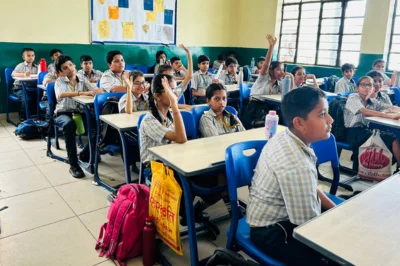Session On Project Astitva

Session On Project Astitva
Introduction
ASTITVA is all about social-emotional learning (SEL) which will help students in showing more compassion and kindness towards themselves and others. SEL is the process by which children and adults regulate their emotions, set goals, demonstrate empathy, build and maintain healthy relationships, and make constructive choices (CASEL, 2019). The goal here is to acknowledge that even as littles, they are capable humans with the capacity to understand and grow. We all are aware that by nature children are curious, so providing them with an appropriate environment is very important. It introduces Social and Emotional Learning (SEL) as a transformative curriculum that aims for holistic student development.
ASTITVA, a social-emotional well-being project kickstarted as a pilot project at Platinum Valley School in Ghaziabad. The curriculum that we have prepared is very much needed for today’s generation. The curriculum is prepared by Nimrata Sinha who is executing this project under the guidance of Rahul Sinha. With the help of our resource person Hina Siddiqui who is a visionary in mental health and emotional wellbeing with 20 years of experience, we executed the program really well. We implemented the project with amazing educational activities which give self-awareness as well as social awareness to students.
Category
Student emotional intelligence and self control
Domains
Self Awareness,
Self Management,
Social Awareness
Subdomain
Grit, Growth mindset, Learning strategies, Social perspective taking, Self-efficacy, Emotion regulation, Classroom effort.
Grades
1st, 2nd, 3rd Grade, 4th Grade, 5th Grade, 6th Grade, 7th Grade, 8th Grade, 9th Grade, 10th Grade, 11th Grade, 12th Grade.
Respondent
Student
Impact of Social-Emotional Learning
Researchers say that, when students are struggling, suppose their school performance is poor, school becomes a source of anxiety for them. Their diminished self-efficacy needs impairment. They can't connect with school and teachers. Many students struggle to verbalize the problems they face.
- Students have more control and ownership of their sections.
- Intrinsically they’ll start taking charge of their academics too.
- They are able to manage their stress better.
- Control of their behavior, emotional reactions also on anxiety.
- Make sure there is a place for students to calm down. This safe space will allow for the student to reflect.
Objectives of the Project
- Mindfulness and Growth Mindset - Aims to cultivate mindfulness and a growth mindset among students.
- Positive Education - Intends to embed positive education and ethical values into the school culture.
- Critical Thinking and Curiosity - Encourages critical thinking and curiosity among students. It will inculcate creativity, confidence, self-awareness, and passion for learning.
- Expression and Development - Focuses on fostering self-expression and holistic development. Understanding and naming of their own emotions.
- NCERT Principles- Aligns with NCERT principles of connecting knowledge to life, shifting away from rote learning, and enriching the curriculum for overall child development.
- Gender sensitivity.
- Equip learners with skills to cope with stressful and conflicting situations in the best possible manner.
- Interpersonal skills: teamwork, communication, coping skills
Conclusion
The risk of social and emotional problems at the adolescent stage is a grave problem to be addressed these days, these skills are crucial to rescue our teens. Taking into account social-emotional problems can both promote and obstruct learning among adolescents. The collaborative action research was imperative in designing and testing social-emotional models for adolescent secondary school students coping with learning. Therefore, teachers and other education departments can influence adolescent coping in learning by ensuring students are heard and safe, also through action-oriented activities, enhancing communicating feelings, guidance, and counseling. These skills enhance strong bonding among adolescents which automatically stimulates students' active engagement and interest in learning. SEL is a great tool for helping adolescents regulate their emotional problems which delay their success in coping with learning at schools.